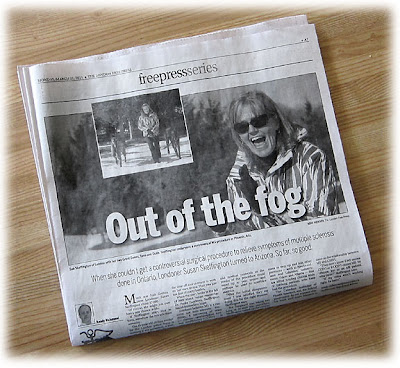 |
| London, The Forest City, as seen from my Bryon home. |
Richmond has a blog, Urban Sub, on Tumblr where he tells us:
"Every workday morning, I leave the suburbs and cross the river to the downtown, where I write stories for the newspaper."
I'm not sure where Richmond lives today but when he started at The Free Press I took his picture posed in his London neighbourhood in the western part of the city. Back then Richmond lived about seven kilometres from work, or a few minutes by car from the paper. I could walk from Randy's home to The Free Press, given the time, he lives that close to work.
Since moving back to London, Richmond says he finds London dull, just as his father did before him. His dad was "a little too comfortable in London." He uprooted his young family and moved to Hamilton. I don't know if his dad found Hamilton suitably uncomfortable but maybe he did; He stayed.
I enjoy reading Richmond's stuff, but he's often more of poet than journalist. His words in that first story got me thinking about suburbs and how one defines them. I have often felt Richmond has a love/hate relationship with suburbs and I have wondered why he lives in what he thinks of as a suburb.
Richmond's Urban sub blog invites his readers to Ask me anything, and so I did. I asked: "Why do you live in the 'suburbs' and not downtown?" Here is his reply:
"Space, bit of nature, and a comfort zone.
Got three kids who like to run around the yards and the street they live on.
Needless to say, I needed space for them and for me to escape from them from time to time.
I grew up in the suburbs of a small town. (A strange thing in itself.)
I have lived in downtown neighbourhoods and felt a bit cramped. That’s just me though.
I know I will be tempted by a downtown condo when I get older."
What a great reply. Very honest. And now I know why I am often at odds with Richmond when it comes to his views on cities. I, too, grew up in what I thought of as a suburb, of sorts, Windsor. When I was a young boy, Windsor felt like a suburb of Detroit. Driving north on Windsor's main street, visitors often mistook the tall skyscrapers of Detroit for Windsor's downtown.
As a young boy my friends and I often spent our Saturdays bumming about Motown. It was as easy to get to Detroit back then as taking the bus, the tunnel bus. We could leave home and be in Detroit in less than thirty minutes. The big city offered lots to do: The Detroit Zoo, Belle Isle and its aquarium, and two amusement parks. There was Bob-lo if you had the time and Edgewater if you didn't.
As a teen I often went to Detroit for clothes. J.L. Hudson's was great for conservative stuff, everyday high school attire. But for that special look, the Friday-night-sock-hop look, it was Todd's Clothes which was opened in 1931 in downtown Detroit by Nathan "Toddy" Elkus who gained fame as the designer of The Zoot Suit. No one carried a better line of shark-skin fabric clothing than Todd's, or tighter men's slacks or had a better selection of narrow-brimmed hats. If you were not careful, you could leave Todd's with the look Lou Rawls' gently mocks in his mid 60s' release of Street Corner Hustler Blues.
I'm very comfortable in cities. Downtown neighbourhoods don't make me feel at all cramped. Certainly not London's. My first home here was just across the Thames River from downtown. I lived on Wilson Street and collected hardballs knocked high and foul by batters at Labatt Park.
My lot went back about 185 feet and I never longed for any more yard. I had more yard when I lived near the core than I do now in Byron. Randy's reason for living in the suburbs, I had "three kids who like to run around the yards and the street they live on," rang completely hollow with me.
His talk about needing a "bit of nature" also rang false with me. When I sought a hit of nature back when I lived near the core, I portaged my canoe to the nearby Thames, launched it at the forks and paddled past herons and turtles to Springbank Park and back.
Richmond writes: "I know I will be tempted by a downtown condo when I get older."
I'm already older and I am already tempted but I'd rather live in downtown Byron than downtown London. Let's be honest, when you get right down to it, is downtown Byron all that distant from downtown London?
 |
| It rarely takes me more than 15 minutes to drive downtown. Mapquest agrees. |
(I think of suburbs as distant places, involving long commutes to work. Some urban experts put the cutoff at half an hour. If it takes more than thirty minutes to drive downtown, you live in a suburb. If it takes less, you may not live in the core but you do live in the city.)




























